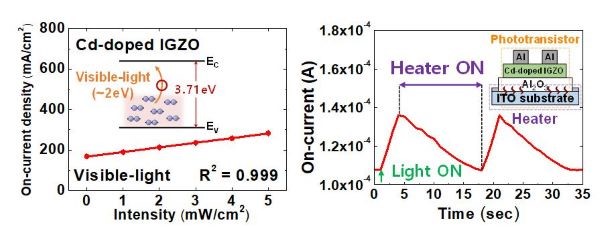Professor Ha Tae-Jun Develops Heater-Integrated Cd-Doped IGZO Visible-Light Phototransistor
- admin
- 2024-12-09
- 1092
Professor Ha Tae-Jun (Department of Electronic Materials Engineering) and His Research Team Develop Heater-Integrated Cd-Doped IGZO Visible-Light Phototransistor
-
Published
in the Optical Materials Science Journal Advanced Optical Materials (IF: 8.0,
Top 8.0% in JCR Ranking)

(Left) Kim Eun-Ha, Integrated Master's and
Doctoral Program; (Right) Professor Ha Tae-Jun
Professor Ha Tae-Jun
(Department of Electronic Materials Engineering) and his research team at our
university have successfully developed a Cd-doped indium-gallium-zinc oxide
(IGZO) phototransistor with enhanced responsiveness in the visible light
spectrum. They also designed a heater-integrated structure, effectively
improving the recovery characteristics of the phototransistor.
The results of this study
were published in Advanced Optical Materials (IF: 8.0, Top 8.0% in JCR
ranking), a leading journal in the field of optical materials science published
by Wiley. The paper is titled “Heater-Embedded Visible-Light Phototransistor
Based on Cd-Doped IGZO Film Fabricated through Microwave-Assisted Sol-Gel
Process.”
(Reference:
https://doi.org/10.1002/adom.202402171)
Recently, oxide
semiconductor IGZO has been widely studied as a channel layer material for
phototransistors due to its excellent responsiveness in the ultra-violet (UV)
range and its high external quantum efficiency (EQE). However, its low
responsiveness in the visible light range, caused by its wide bandgap, and the
persistent photoconductivity (PPC) characteristic of oxide semiconductors
present challenges for its practical application as a visible-light
phototransistor. In response, Professor Ha Tae-Jun (Department of Electronic
Materials Engineering) and his research team doped IGZO with the metal ion Cd,
which reduces its bandgap and promotes the formation of oxygen vacancies,
thereby facilitating visible light absorption. Additionally, they significantly
improved the recovery characteristics of the phototransistor through Joule
heating. Notably, the team successfully developed a device that simultaneously
functions as a heater and a phototransistor by utilizing an indium-tin oxide
(ITO) substrate, which serves both as the gate electrode of the phototransistor
and as a Joule heating element. The fabricated Cd-doped IGZO phototransistor
demonstrated a significant improvement in visible light responsiveness,
increasing from 1.89 A/W to 22.6 A/W compared to conventional IGZO
phototransistors. Additionally, it exhibited excellent linearity in
photoresponse with respect to light intensity, highlighting its reliability in
sensing performance. Furthermore, the Joule heating effect of the ITO substrate
significantly reduced the recovery time from approximately 1,300 seconds to
just 12 seconds, demonstrating the potential for practical applications of
oxide semiconductor-based phototransistors.

Analysis of visible light sensing performance and recovery characteristics of heater-integrated Cd-doped IGZO phototransistors
This study, conducted
solely by Professor Ha Tae-Jun's research team, is a result of the Interactive
Display Research Center, led by Professor Ha as its director, and was supported
by the University's Innovative Future Challenge Project. Additionally, the
study was conducted with support from the Carbon Neutral Industrial Core
Technology Development Program, overseen by the Ministry of Trade, Industry,
and Energy. This program, carried out over eight years from 2023 to 2030,
involves Samsung Display as the primary demand partner. Professor Ha Tae-Jun's
research team is responsible for developing oxide semiconductor transistor
devices and processes as part of this initiative.
Professor Ha Tae-Jun's
research team conducts extensive studies on next-generation electronic devices
based on advanced semiconductor materials. Their work includes publishing over
60 papers in SCI journals and securing more than 30 international and domestic
patents, with a focus on oxide semiconductors and related technologies.
Additionally, Kim Eun-Ha, the first author, achieved the outstanding accomplishment
of publishing a paper in a top-tier international journal during her first
semester in the integrated master's and doctoral program.
https://www.kw.ac.kr/ko/life/research.jsp?BoardMode=view&DUID=48558?